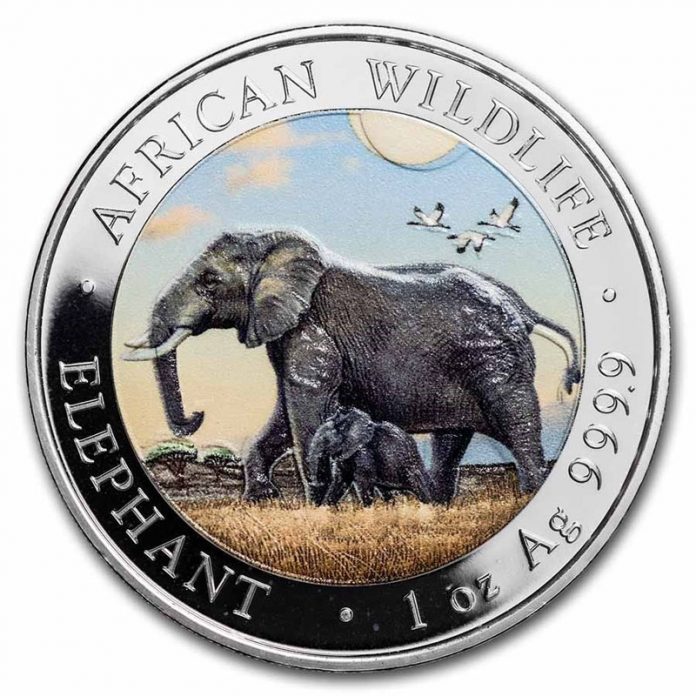
The popularity of coins with color on them drives certain segments of rare coin markets and collectors. Morgan Dollars, type coins, and classic commemoratives are all distinct types of numismatic coins where beautiful and original colors bring strong premiums. An ever-growing segment of the coin market appreciates natural color on coins. Non-collectors are also attracted to the colorful images, even though the coins are secondary.
In April 2004, Superior Galleries offered a beautifully toned 1926 Oregon Trail Commemorative Half Dollar, graded MS67, at a public auction in California. The coin brought $69,000. That’s 34.5 times its graded value of $2,000. Why? Because of the coin’s beautiful, natural and original color.
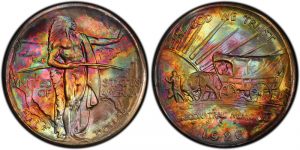
PHOTO COURTESY OF PCGS COINFACTS
Natural Toning
Naturally toned coins have great eye appeal for many collectors and dealers. Silver coins are especially subject to toning or tarnish when exposed to light, air and an environment conducive to toning. That natural, but equally unpredictable toning process can take decades to acquire, and specific results are not guaranteed. This story illustrates how much original and beautiful color on a coin can drive the price upwards and make it incredibly desirable. Because of the growing demand for colorful coins, if Mother Nature doesn’t supply the colors, there are other means of adding color. But as important as the appearance of a colorized coin is how and where the color was applied. Was the color added in the secondary market, which numismatists frown on, or was it an integral part of the minting process? The answer to that question often determines the popularity of that coin by the numismatic public.
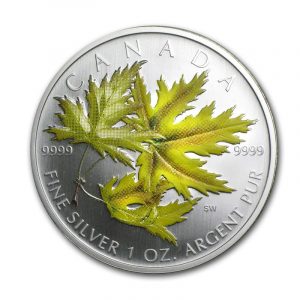
Adding Color
Adding color to coins or rounds is not a new idea. The history of colorized or layered coins spans more than 30 years. In its infancy, colorized coins were hand-painted with enamel paint. I remember seeing the wonderfully patient and talented artists at a coin dealership who were adding enamel paint color to holiday silver rounds by hand with very thin special brushes. The results were excellent.
Later, people began applying stickers, or appliques, to cover one side of the coin with a colorful image of the coin itself or something completely different. While these stickers were not as attractive as a hand-painted product, the stickers satisfied the demands of a mass audience.
Advertising in newspapers, magazines, television and direct mail would often include advertising for 1976 Bicentennial coins with patriotic stickers applied or clad Kennedy Half Dollars with stickers of American
Presidents, or State Quarters or American Silver Eagles with patriotic motifs attached. Enterprising organizations began adding artificial color to the surface of the coin. The first colorized coins offered to the public were struck by Coin Invest Trust (CIT), a private mint in Europe after they developed a chemical and mechanical process for adding color to the coins. This process allowed them to bond the color to the metal.
Producing Colorized Coins
Through an agreement with the Pacific Island nation of Palau, CIT struck a coin in 1992 that commemorated Marine Life Protection. This $5 denomination Silver Proof coin depicted Poseidon with this trident on the obverse (uncolored) side and a colorful assortment of tropical fish on the other colorized side. The coin was so successful that Palau has authorized many colorized coins since then. Many other nations saw how the public embraced these coins and decided to follow suit.
By 1993, Equatorial Guinea and Uganda, two African nations not particularly well-known for their innovative coinage, entered the fray. Even war-torn Somalia currently issues colorized commemorative coins. One popular Somalian series is the African Wildlife Series. One new (2022) issue is the popular and endangered African Elephant.
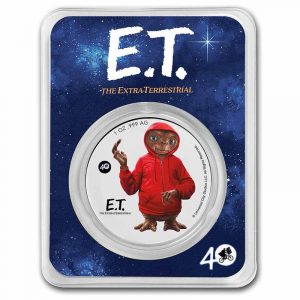 Colorized Circulating Coins
Colorized Circulating Coins
In 2004, Canada, a nation that is always progressive in its variety of inventive coinage, was the first nation to issue a colorized circulating coin. The Canadian 25 Cent Poppy coin was issued in honor of Canada’s 117,000 war dead. The coin had a red poppy emblazoned across the back and a protective coating over it so the color wouldn’t wear off easily. The quarter nearly caused an international spying incident when several U.S. military contractors acquired some in change and thought the coins, because of their unusual appearance, may have some type of nano-technology transmitters on them. The contractors reached out to the U.S. Department of Defense and were assured these coins were not espionage equipment.
Since that time, the Royal Canadian Mint has utilized that technology on numerous occasions to create different colorized coins. Some of the most popular coins have been the colorized Maple Leaf silver bullion coins, with their bold, bright and seemingly natural colors.
Australia has experimented with colorized coins and its engraving technology. They developed an idea to vary the depth of the engraved subject to enhance the detail and colors.
Countries that you wouldn’t expect joined the rush to authorize colorized coins – Mongolia, the Cook Islands, Congo, Liberia, the Northern Mariana Islands and Cameroon are just a few.
Today there are close to 50 sovereign nations that offer colorized coinage and there are many hundreds of different issues. The topics range from world leaders to cartoon characters, from race cars to every conceivable type of animal or insect. Everyone strives to find a topic that hasn’t already been covered. In addition, many colorized coins also come in a wide variety of shapes including guitars, animals and cars.
MC Garofalo is APMEX’s Director of the Ecommerce Experience and has been in the precious metal and rare coin business for more than a dozen years. “The growth of APMEX’s business in colorized coins has been phenomenal. Both young and old customers love their favorite movies, video games and superheroes! The nostalgia is represented on these bright, beautiful coins and rounds. They love owning them.”
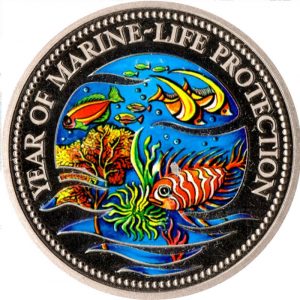
What About the U.S. Mint?
Many people wondered when and if the United States Mint would create and issue a colorized coin. In August 2020, the Mint released a colorized coin set for the 60th Anniversary of the Naismith National Basketball Hall of Fame. These commemorative coins were truly an innovation for the ‘late-joining’ U.S. Mint.
The Basketball Hall of Fame set of three commemorative coins included a clad Half Dollar, a Silver Dollar and a Five Dollar Gold coin. The clad half dollar had a realistic-looking basketball flying through a color rim and net. The silver dollar had color on the channels on the basketball and the net and rim. The gold coin had no colorization. The Mint released coins with and without color in proof and uncirculated finishes. None of the coins sold out their maximum authorized mintage. The U.S. Mint did reveal, because of a Freedom of Information Act request, that the color was applied by a third-party company in Massachusetts. This same company revealed that it has done similar colorization work for many, major world mints.
Two years later, the U.S. Mint again offered a colorized coin — a2022 National Purple Heart Hall of Honor Colorized Silver Dollar. This coin was struck at the West Point minting facility and bears a “W” mintmark. The purple heart is awarded to U.S. military personnel killed or wounded in enemy action. There is a purple color on the coin which matches the appearance of the actual award medal. The colorized version was limited to 25,000 coins and sold out within a month.
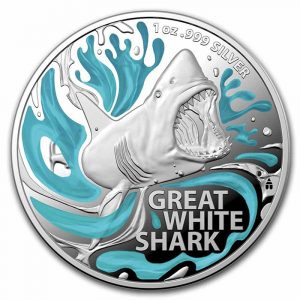
Gaining Acceptance
It seems that for U.S. Mint customers, the subject matter is more important than simply adding color. The U.S. Mint would be wise to limit the numbers and topics for colorization going forward. But perhaps, the U.S. Mint’s attempt at marketing colorized coins will make them more acceptable to seasoned collectors. It is becoming a typical U.S. Mint issue rather than just a novelty, so gaining acceptance by the veteran audience is important.
There is no doubt the world’s sovereign and private mints are striking colorized coins at a rapid pace with almost no thought as to whether they will sell or not. The more often a cultural icon (think Superman, Batman, Marvel Super Heroes, etc.) is represented on a colorized coin, the more the general public seems to like it.
Witness the number of colorized coin offerings for superheroes, video games, exotic animals and newly released movies and how quickly they sell out as soon as they are offered. The market for buying and enjoying colorized coins shows no signs of abating. If even the staid and conservative U.S. Mint can issue a couple of colorized coins, then which world mint would not follow along?
“You either adapt to what the marketplace wants, or you risk being left behind, “ concluded MC Garofalo. “Whichever colorized coins you choose to collect, enjoy them. They are meant to bring back wonderful memories – just for you!”
This article about colorized coins previously appeared in COINage magazine. To subscribe click here. Article by Mike Garofalo.














